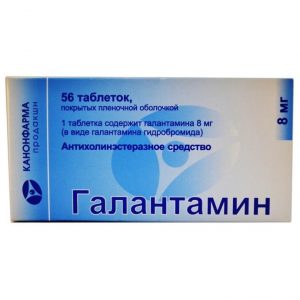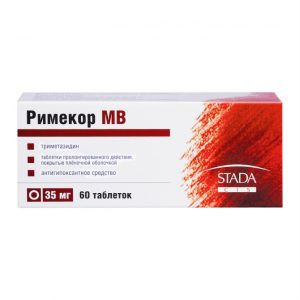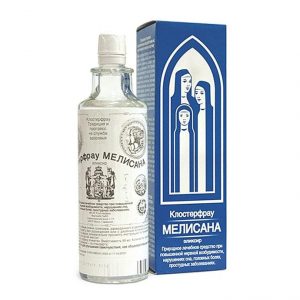Description
Release form
Tablets, film-coated
Packing
20 pcs.
The pharmacological action of
Torendo is an antipsychotic (antipsychotic).
Pharmacodynamics
Risperidone is an antipsychotic and also has a sedative, antiemetic, and hypothermic effect. Risperidone is a selective monoaminergic antagonist with a pronounced affinity for serotonergic 5-HT2 and dopaminergic D2 receptors, it also binds to alpha1-adrenergic receptors and, with a slightly lower affinity, to H1-histaminergic and alpha2-adrenergic receptors. It has no tropism for cholinergic receptors.
Antipsychotic effect due to blockade of dopamine D2 receptors of the mesolimbic and mesocortical system.
Sedative effect is caused by blockade of adrenoreceptors of the reticular formation of the brain stem antiemetic effect – blockade of the dopamine D2 receptors of the trigger zone of the vomiting center hypothermic effect – blockade of the dopamine receptors of the hypothalamus.
Reduces productive symptoms (delirium, hallucinations), automatism. It causes less suppression of motor activity and to a lesser extent induces catalepsy than classical antipsychotics (antipsychotics).
Balanced central antagonism of serotonin and dopamine may reduce the risk of extrapyramidal symptoms.
Risperidone may cause a dose-dependent increase in plasma prolactin concentrations.
Pharmacokinetics of
When ingested, risperidone is completely absorbed (regardless of food intake) and maximum plasma levels are observed after 1-2 hours.
Risperidone is metabolized by P-450 IID6 cytochrome to form 9-hydroxy-risperidone, which has a similar pharmacological effect. Risperidone and 9-hydroxy-risperidone are an effective antipsychotic fraction. Further risperidone metabolism is N-dealkylation. When taken orally, risperidone is excreted with a half-life of about 3 hours. It was found that the half-life of 9-hydroxy-risperidone and the active antipsychotic fraction is 24 hours.
In most patients, an equilibrium concentration of risperidone is observed one day after the start of treatment. The equilibrium state of 9-hydroxy-risperidone in most cases is achieved 3-4 days after the start of treatment.
The concentration of risperidone in plasma is proportional to the dose of the drug (within therapeutic doses).
Risperidone is rapidly distributed in the body. The volume of distribution is 1-2 l / kg. In plasma, risperidone is bound to albumin and acidic alpha-1-glycoprotein. The risperidone fraction, which is bound by the plasma protein, is 88% and 77%, respectively, in the case of 9-hydroxy-risperidone.
It is excreted by the kidneys – 70% (of which 35-45% in the form of a pharmacologically active fraction) and 14% with bile. With a single dose, there are high levels of active plasma concentrations and slow elimination in elderly patients and patients with insufficient renal function.
Indications
– Acute and chronic schizophrenia and other psychotic conditions with productive and / or negative symptoms.
– Affective disorders in various mental illnesses.
– Behavioral disorders in patients with dementia with symptoms of aggressiveness (outbursts of anger, physical abuse), with mental disorders (agitation, delirium) or psychotic symptoms.
– As an adjunct therapy in the treatment of mania in bipolar disorders.
– As an adjunctive therapy for behavioral disorders in adolescents from 15 years of age and adult patients with reduced intellectual level or mental retardation, in cases where destructive behavior (aggressiveness, impulsivity, autoaggression) is the leading one in the clinical picture of the disease.
Contraindications
Lactation.
– Children and adolescents under 15 years of age (efficacy and safety not established).
– Hypersensitivity to the drug.
With caution, the drug should be used for diseases of the cardiovascular system (chronic heart failure, myocardial infarction, cardiac conduction disturbances), dehydration and hypovolemia, cerebrovascular accident, Parkinson’s disease, seizures (including history), renal or severe liver failure, drug abuse or drug dependence, conditions predisposing to the development of tachycardia such as pirouette (bradycardia, disorders e electrolyte balance, concomitant use of drugs that extend the QT interval), brain tumors, intestinal obstruction, cases of acute overdose of drugs, Reye syndrome (the antiemetic effect of risperidone may mask the symptoms of these conditions).
Pregnancy and lactation
The safety of pregnant women has not studied risperidone. During pregnancy, it can only be used if if a positive effect justifies a possible risk.
Since risperidone and 9-hydroxy-risperidone pass into breast milk, women using the drug should not breast-feed
Special instructions
With schizophrenia at the beginning of treatment with risperidone, it is recommended to gradually cancel the previous therapy, if it is clinically justified. If patients are transferred from therapy with depot forms of antipsychotic drugs, it is recommended that the use of risperidone be started instead of the next planned injection. Periodically, the need to continue therapy with potivoparkinsonian drugs should be assessed. In connection with the A-adrenergic blocking effect of risperidone, orthostatic hypotension may occur, especially during the initial dose selection. If arterial hypotension occurs, consider reducing the dose. In patients with diseases of the cardiovascular system, as well as with dehydration, hypovolemia or cerebrovascular disorders, the dose should be increased gradually, as recommended. The occurrence of extrapyramidal symptoms is a risk factor for the development of tardive dyskinesia. If signs and symptoms of tardive dyskinesia occur, consideration should be given to canceling all antipsychotic drugs. When a neuroleptic malignant syndrome characterized by hypertension occurs, muscle rigidity, instability of autonomous functions, impaired consciousness and increased levels of CPK, it is necessary to cancel all antipsychotic drugs, including risperidone. With the abolition of carbamazepine and other inducers of hepatic enzymes, the dose of risperidone should be reduced. Patients should refrain from overeating due to the possibility of increasing body weight. The use of the drug in children under the age of 15 years is not recommended. During treatment, it is necessary to refrain from engaging in potentially hazardous activities that require an increased concentration of attention and speed of psychomotor reactions, as well as from drinking alcohol (ethanol).
Composition
1 film-coated tablet contains:
active substance: risperidone 1 mg.
excipients: cellulose *, microcrystalline cellulose, croscarmellose sodium, silicon dioxide, colloidal anhydrous, sodium lauryl sulfate, magnesium stearate.
shell: Opadry OZN28785 white **, iron dye yellow oxide E 172. * Cellactose is a spray-dried compound consisting of 75% alpha-lactose monohydrate and 25% cellulose powder, dry matter ** Opadray OZN28785 is a ready-made mixture of hypromellose, titanium dioxide, talc, propylene glycol
Dosage and administration of
Schizophrenia.
Adults and children over 15 years of age. Risperidone can be prescribed once or twice a day. The initial dose is 2 mg per day. On the second day, the dose should be increased to 4 mg per day. From this point on, the dose can either be maintained at the same level or individually adjusted if necessary. Usually the optimal dose is 4-6 mg per day. In some cases, a slower dose increase and lower initial and maintenance doses may be warranted.
Doses above 10 mg per day have not shown higher efficacy compared to lower doses and may cause extrapyramidal symptoms. Due to the fact that the safety of doses above 16 mg per day has not been studied, doses above this level cannot be used.
Information on the use of the drug for the treatment of schizophrenia in children under 15 years of age is not available.
Elderly patients. An initial dose of 0.5 mg twice daily is recommended. The dosage can be individually increased by 0.5 mg twice a day to 1-2 mg twice a day.
Diseases of the liver and kidneys. An initial dose of 0.5 mg per dose is recommended 2 times a day. This dose can gradually be increased to 1-2 mg per dose twice a day.
Drug abuse or drug dependence – the recommended daily dose of the drug is 2-4 mg.
Behavioral disorders in patients with dementia.
An initial dose of 0.25 mg per day is recommended twice daily (adequate dosage form should be used). If necessary, the dosage can be individually increased by 0.25 mg 2 times a day, not more often than every other day. For most patients, the optimal dose is 0.5 mg twice daily. However, some patients are shown taking 1 mg 2 times a day.
Once an optimal dose is reached, a once-daily dose may be recommended.
Mania for bipolar disorder
The recommended starting dose of Torendo is 2 mg per day at a time. If necessary, this dose can be increased by 2 mg per day, not more often than every other day. For most patients, the optimal dose is 2-6 mg per day. Behavioral disorders in patients with mental retardation
Patients weighing 50 kg or more – the recommended initial dose of the drug is 0.5 mg once a day. If necessary, this dose can be increased by 0.5 mg per day, not more often than every other day. For most patients, the optimal dose is 1 mg per day. However, for some patients, 0.5 mg per day is preferable, while some require an increase in dose to 1.5 mg per day.
Patients weighing less than 50 kg – The recommended starting dose of Torendo is 0.25 mg once daily. If necessary, this dose can be increased by 0.25 mg per day, not more often than every other day. For most patients, the optimal dose is a dose of 0.5 mg per day. However, for some patients, 0.25 mg per day is preferred. while others require a dose increase of up to 0.75 mg per day.
Long-term use of risperidone in adolescents should be carried out under the constant supervision of a physician.
Use in children under 15 years of age is not recommended.
Side effects of the
From the nervous system: insomnia, agitation, anxiety, headache, sometimes drowsiness, increased fatigue, dizziness, impaired attention, blurred vision, rarely extrapyramidal symptoms (tremor, stiffness, hypersalivation, bradykinesia, acute dystonia), mania or hypomania, stroke (in elderly patients with predisposing factors), as well as hypervolemia (either due to polydipsia or due to the syndrome of inadequate secretion of antidiuretic hormone), tardive dyskinesia (involuntary rhythmic movements of the tongue and / or face mainly), neuroleptic malignant syndrome (hyperthermia, muscle rigidity, instability of autonomous functions, impaired consciousness and an increase in creatine phosphokinase levels), thermoregulatory disorders and epileptic seizures.
From the digestive system: constipation, dyspepsia, nausea or vomiting, abdominal pain, increased activity of hepatic transaminases, dry mouth, hypo-or hypersalivation, anorexia and / or increased appetite, increased or decreased body weight.
From the cardiovascular system: sometimes orthostatic hypotension, reflex tachycardia, or increased blood pressure.
From the hemopoietic organs: neutropenia, thrombocytopenia.
From the endocrine system: galactorrhea, gynecomastia, menstrual irregularities, amenorrhea, weight gain, hyperglycemia and exacerbation of preexisting diabetes mellitus.
From the genitourinary system: priapism, impaired erection, impaired ejaculation, anorgasmia, urinary incontinence.
Allergic reactions: rhinitis, rash, angioedema, photosensitivity.
From the skin: dry skin, hyperpigmentation, itching, seborrhea.
Other: arthralgia.
Drug Interactions
Since risperidone primarily affects the central nervous system, it should be used with caution in combination with other centrally acting drugs and ethanol. Risperidone decreases the effectiveness of levodopa and other dopamine agonists. Clozapine reduces the clearance of risperidone. When using carbamazepine, a decrease in the concentration of the active antipsychotic fraction of risperidone in plasma was noted. Similar effects can be observed when using other inducers of hepatic enzymes. Phenothiazines, tricyclic antidepressants and some A-blockers can increase plasma risperidone concentrations, but this does not affect the concentration of the active antipsychotic fraction. Fluoxetine may increase plasma risperidone concentrations, however, to a lesser extent, the concentration of the active antipsychotic fraction, therefore, the dose of risperidone should be adjusted. With the simultaneous use of risperidone with drugs that bind to plasma proteins to a high degree, there is no clinically pronounced displacement of any drug from the protein fraction of plasma. Antihypertensive drugs increase the severity of lowering blood pressure on the background of risperidone.
Overdose
Symptoms: drowsiness, sedation, depression of consciousness, tachycardia, hypotension, extrapyramidal disorders, in rare cases prolongation of the QT interval.
Treatment: It is necessary to ensure the free passage of the respiratory tract to ensure adequate oxygenation and ventilation, gastric lavage (after intubation if the patient is unconscious) and the appointment of activated charcoal in combination with laxatives. Symptomatic therapy aimed at maintaining vital functions of the body. To timely diagnose possible heart rhythm disorders, ECG monitoring should be started as soon as possible. Careful medical monitoring and ECG monitoring are carried out until the symptoms of intoxication disappear. There is no specific antidote.
Storage Conditions
The product should be stored out of the reach of children at a temperature not exceeding 30 ° C.
Shelf life
2 years.
Deystvuyushtee substance
Risperidone
Terms and conditions
prescription
dosage form
tablets
Possible product names
TORENDO 0.001 N20 TABLE P / O
TORENDO TAB P / O 1MG No. 20
Torendo tab pg / p / o x 20
TORENDO TAB. POKR. CAPTIVITY. OBOL. 1 MG (BLISTERS) No. 20
Torendo tablets 1 mg, 20 pcs.
KRKA d.d. Novo mesto AO, Slovenia




